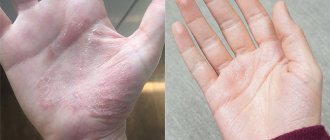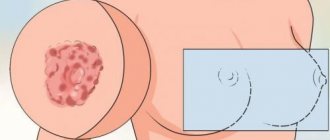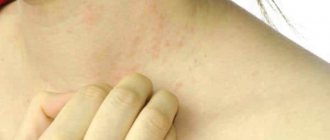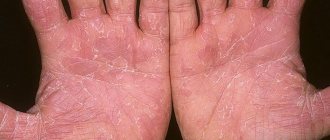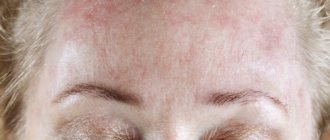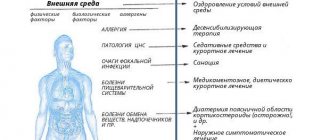- August 3, 2018
- Dermatology
- Yaroslav Rogozin
Weeping dermatitis is a nasty branch of dermatitis. As a rule, this type of dermatitis causes discomfort and, of course, discomfort in patients. This type of dermatitis has its own unique feature. He, like others, has a rash on a certain area of the skin, but it is not dry. From these same wounds, a fluid called ichor leaks out. Many experts call weeping dermatitis the most serious and severe disease in this area. This is justified by the fact that the disease occurs with a lot of discomfort for the patient and there are certain difficulties associated with treatment.
Causes of this disease
You should not look for the cause somewhere far away, because the cause of this type of complication depends solely on the patient. Any factor that has an irritating effect on the skin is a potential cause of weeping dermatitis. The main reasons that activate weeping dermatitis may be:
- The first reason is, of course, an allergy to a particular food product;
- This is followed by disorders of the human nervous system;
- The body can react in this way to a particular medication;
- Cosmetic products can also cause allergies and lead to this type of illness.
But as for the main causes of this disease, it is the improper functioning of the kidneys and pancreas, as well as the liver. Insufficient functioning of all of the above organs leads to the fact that food is poorly digested and absorbed in the body. Based on this, the human body is exposed to so-called intoxication. For these reasons, the body accumulates substances that are waste and this has a negative effect on the skin of our body. And if all this is accompanied by constant fatigue and stress, then this is a direct path to weeping dermatitis.
Preventive actions
To avoid the development of weeping dermatitis, you need to follow the recommendations of doctors regarding prevention:
- strictly observe the rules of personal hygiene;
- avoid nervous disorders, stress and depression; if necessary, you can and should seek help from a psychologist or neurologist;
- timely treatment of diseases of internal organs;
- control your diet and diet to avoid digestive system disorders;
- If you have allergies, avoid contact with allergens.
If the patient promptly sought professional medical help for weeping dermatitis, then competent treatment will prevent the development of the acute form of the disease into a chronic one. If weeping dermatitis has already taken a chronic form, then during periods of remission, patients should strengthen their immunity and strictly follow all the recommendations and prescriptions of the attending physician.
Tsygankova Yana Aleksandrovna, medical observer, therapist of the highest qualification category
21, total, today
( 41 votes, average: 4.71 out of 5)
Coccidioidomycosis - why it occurs, how to treat
How to treat advanced nail fungus
Related Posts
Types of weeping dermatitis
Medical experts have spent a lot of time studying this particular type of dermatitis and have come to the conclusion that this disease is divided into three categories, which have their own specific characteristics.
The first type acquired the name – professional. It can develop only due to fairly frequent contact with chemical products.
The second type is called piokovic. It develops due to a large number of bacteria that live in the body, so-called colonies.
And the third type is household dermatitis. As a rule, it is household chemicals, which include detergents, that influence the onset of this disease. The onset of this disease is associated with the activation of fungal types of infection.
The symptoms of each type of weeping dermatitis are quite varied. This type of disease tends to manifest itself differently depending on the age of the patient. Weeping atopic dermatitis in children under two years of age manifests itself due to the formation of a so-called crust on the skin. The area affected by this disease in these children is the face and the folds of the limbs of the body.
If the age group is over 12 years old, then there are symptoms. The rash in such a teenager will spread to almost all areas of the body. The areas of the skin that are affected by the disease have become red and crack, which leads to the leakage of the ichor.
As for adults, their symptoms are identical to those in children. The only difference is that the skin becomes thicker.
Symptoms of the disease
Signs of the disease may vary depending on the age of the patient.
In children under 3 years of age, the disease is expressed in the form of rashes, located against the background of redness of the skin, followed by the formation of weeping ulcers. After the weeping stops, the inflamed areas turn pale and become covered with serous crusts. The lesions are initially located on the face, and later spread to the surface of the head and the bends of the limbs.
In children from 3 to 12 years of age, redness and rashes spread to the neck, wrists, back of the hands, bends of the knees and elbows. Next, bubbles with liquid contents form, which, after opening, leave compacted areas. Such blisters do not dry out for a long time and require prolonged treatment.
Adolescents 12 years of age and older have the same symptoms as the previous age category. It is characteristic that the acute stage of the disease can suddenly be replaced by a period of subsidence of active inflammation.
In patients over 18 years of age, weeping dermatitis can manifest itself throughout the body, in the form of redness of the skin and the further formation of rashes and cracks with liquid inside them.
Carrying out diagnostics in this case
When you feel these symptoms, you should consult a doctor as soon as possible. And in order for them to accurately indicate your diagnosis, it is necessary to provide all the information about the existing symptoms. Details about the disease should include information such as how quickly it occurs, the results of any tests, and the nature of skin irritation.
Only after the doctor knows all the necessary information will he be able to establish a clear diagnosis and prescribe the correct treatment for it.
Proper treatment for weeping dermatitis
Weeping atopic dermatitis requires a certain approach to yourself. This type of disease must be treated in the same way as any other. As a rule, the treatment includes: improving the immunity of a sick person, diet, medications of a certain type, avoiding stress, using ointments on the affected areas of the skin.
As for stress, doctors have long determined that stress adds to the rate of development of dermatitis. Based on this, a sick person must not only use all medications, but also try to refrain from stressful situations.
Prevention measures
With proper and timely treatment, atopic dermatitis is completely cured by the age of 20. In advanced cases, the disease can persist and manifest itself with seasonal exacerbations throughout life.
In order to avoid repeated attacks, you should follow simple recommendations from specialists:
to live an active lifestyle;- eat rationally;
- avoid nervous tension, stress and anxiety;
- get rid of bad habits;
- engage in active sports: swimming, running, breathing exercises;
- promptly treat viral and infectious diseases.
Treatment of atopic dermatitis is complex and time-consuming, but if you follow all the doctor’s recommendations, you can completely get rid of the disease.
Providing treatment with medications
Many people wonder how to treat weeping dermatitis. There's nothing special here. Doctors advise their patients to use drugs that are classified as antiallergic. Drugs called Claretin and Telfast help a lot. These types of drugs have virtually no negative effects. The effects that the above drugs provide will not have a positive effect on a certain area of the skin unless additional hormonal drugs are taken. As a rule, it is topical medications that can be used by patients in this case. They contain a substance such as zinc. It is also important to remember that you should not use medications that have not been approved by your doctor.
Treatment with folk remedies
Weeping dermatitis in an infant is much more difficult to treat than the same disease in an adult. Many people also use folk remedies as treatment, but we must remember that this cannot be done without a doctor’s permission.
So, the first way to treat weeping dermatitis in a baby using the traditional method is treatment with potatoes. The potatoes must be grated so that juice and so-called gruel are formed. This mixture is used externally and applied to the diseased skin. This application must be carried out several times a day. Potatoes have an excellent effect that promotes the healing of these wounds.
The leaves of a plant such as periwinkle are also excellent for wound healing. Its flowers and leaves must be crushed as best as possible. This mixture should be poured with a glass of vegetable oil, left in the sun for one month, and only then will it be suitable for use. The affected areas of the skin should be lubricated with the resulting mixture; after holding it for a couple of hours, it should be washed off only with warm water.
You can also take one spoon of this periwinkle and pour it with a glass of water. The next 10 minutes you need to cook the contents over low heat. Many people add this decoction to their bath or simply smear it on their skin.
Treatment in young children
Weeping dermatitis in infants occurs quite often. If the baby is breastfed, then his treatment will depend on the mother. She should review her diet and remove a number of foods from her diet. These include garlic and onions, broths that contain meat and radish. Spicy seasonings should not be added to dishes. You should also not use bread in large quantities in your diet, as well as pasta products. Fermented milk products are allowed to be used. Based on the baby’s age, the doctor prescribes treatment and medications of one type or another.
Every parent should remember that they cannot treat their child on their own. This can lead to one or another complication.
How to treat atopic dermatitis?
The disease is also called atopic eczema, exudative-catarrhal diathesis, neurodermatitis.
The main factor causing the appearance of atopic dermatitis is exposure to allergens. The disease affects 15-30% of children and 2-10% of adults, and the incidence is increasing worldwide. And over the past 16 years, the number of cases has approximately doubled. The reason for this is the following factors:
- Poor environmental situation,
- Increased amount of stress
- Violation of the principles of proper and healthy nutrition,
- Increased exposure to allergens, primarily of chemical origin.
Interesting fact:
2/3 of the cases are female. The disease most often affects residents of large cities.
https://www.youtube.com/watch?v=ytpolicyandsafetyen-GB
In some patients, the first symptoms of atopic dermatitis are observed in childhood, while in others the disease is latent and first appears only in adulthood.
In children, the disease manifests itself mainly in the first year of life. This feature is influenced by the characteristics of children's skin that distinguish it from the skin of adults:
- Insufficient development of sweat glands,
- Fragility of the stratum corneum of the epidermis,
- Increased content of lipids in the skin.
There is no one way or cure to cure dermatitis. This disease requires complex treatment.
The disease is treated by a dermatologist or allergist. You may need to consult an endocrinologist or gastroenterologist.
Treatment has the following goals:
- Achieving remission
- Reducing the severity of symptoms and inflammatory processes,
- Prevention of severe forms of dermatitis and respiratory manifestations of allergies,
- Improving the quality of life of patients and restoring their ability to work.
Measures to treat the disease:
- Preventing the entry of identified allergens into the body,
- Increased skin barrier function,
- Anti-inflammatory treatment,
- Treatment of concomitant diseases (asthma, rhinitis, conjunctivitis, bacterial, fungal and viral infections),
- Reducing the body's sensitivity to allergens (desensitization),
- Detoxification of the body.
Diet therapy
Dermatitis often goes side by side with food allergies. Therefore, during the period of exacerbation, the patient is prescribed a hypoallergenic diet. However, in the chronic phase of the disease, the diet must also be followed, although not in such a strict form.
It is necessary to exclude from the patient’s diet both foods containing potential allergens - fish and seafood, soy, nuts, eggs, and foods containing an increased amount of histamine - cocoa, tomatoes. Products containing dyes and preservatives, and semi-finished products are removed from the diet. The amount of salt is limited (no more than 3 g per day).
The list of drugs used for treatment depends on the severity of the disease. The most commonly used are first and second generation antihistamines, as well as anti-inflammatory drugs. Many first-generation antihistamines, such as Diphenhydramine, Suprastin, Tavegil, also have a sedative effect, which allows them to be prescribed to patients suffering from sleep disorders.
However, the sedative effect means they are contraindicated in people who require alertness. In addition, first-generation drugs can be addictive during long-term therapy. In this case, second-generation drugs (Cetirizine, Ebastine, Fexofenadine, Astemizole, Loratadine) are more effective.
Concomitant infections are treated with antibacterial agents, skin herpes with antiviral drugs based on acyclovir.
Anti-inflammatory treatment may include corticosteroid medications, both topical and oral. Glucocorticosteroids are prescribed orally only during exacerbation of the disease. In the form of ointments, GCS are used both in the chronic course of the disease and during exacerbation. Combination drugs are also used (GCS, antibiotic, antifungal agent).
Despite the high effectiveness of corticosteroids, it should be remembered that they have many side effects. In particular, they can negatively affect internal organs with long-term use and cause drug dependence. The most commonly used ointments contain glucocorticosteroid drugs such as Hydrocortisone, Dexomethasone, Prednisolone.
Oil-based emollients and moisturizers (emollients) are prescribed externally. If there is exudation, lotions are used (tincture of oak bark, solutions of rivanol and tannin).
Also applicable:
- Calceneurin inhibitors;
- Membrane stabilizing drugs;
- Vitamins (primarily B6 and B15) and polyunsaturated fatty acids;
- Drugs for the treatment of gastrointestinal diseases (enzyme preparations, drugs against dysbacteriosis, enteric agents);
- Immunomodulators (indicated only for severe forms and ineffectiveness of other treatment methods);
- Antibiotics and antiseptics (to combat secondary bacterial infections);
- Antifungal drugs (for the treatment of fungal infections);
- Tranquilizers, antidepressants, antipsychotics and sedatives (to reduce depression and reactivity of the autonomic nervous system);
- Peripheral alpha-blockers;
- M-anticholinergics.
Immunomodulators include drugs that affect the functions of the thymus, B-correctors.
It should be remembered that for atopic dermatitis, alcohol and alcohol solutions are prohibited as antiseptics, as they excessively dry the skin.
Dependence of the choice of treatment methods on the severity of symptoms
| Severity of atopic dermatitis symptoms | medicinal products |
| Expressed only by dry skin | elimination of allergens, use of skin moisturizers |
| Minor | corticosteroids with weak activity |
| Moderate | moderate to strong corticosteroids |
| Heavy | immunosuppressants, phototherapy |
Non-drug methods include maintaining an optimal indoor microclimate, proper selection of clothing, and nail care. Maintaining the required temperature and humidity in the room reduces skin irritation and sweating. The optimal temperature for patients with atopic dermatitis is 20-22°C during the day and 18-20°C at night, the optimal humidity is 50-60%. People suffering from dermatitis should wear clothes only made from natural materials (cotton, linen, flannel, bamboo).
It is necessary to stop using household chemicals that cause irritation: varnishes, paints, floor and carpet cleaners, washing powder, etc.
An important element of therapy is skin care, including the use of moisturizing and softening cosmetics that:
- restore the integrity of the epidermis,
- strengthen skin barrier functions,
- protect the skin from exposure to irritants.
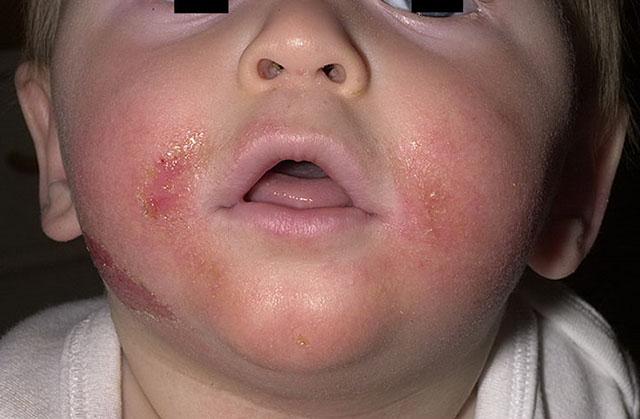
Moisturizers must be applied to the skin regularly, at least twice a day. You can do this more often, every 3 hours, the main thing is to make sure that the skin is not dry. During an exacerbation, a larger amount of the drug is required. First of all, moisturizers should be applied to the skin of the hands and face, as they are exposed to more intense irritants.
It is also recommended for patients:
- reduce the amount of stress;
- carry out daily wet cleaning of the premises;
- remove from the room items that cause dust accumulation, such as carpets;
- do not keep pets at home, especially those with long hair;
- limit intense physical activity;
- use hypoallergenic cosmetics;
- Avoid exposure of the skin to cold, direct sunlight, tobacco smoke, burns.
To wash the body, it is necessary to use detergents with a low pH (especially during an exacerbation period). It is not recommended to wash the main areas of skin damage during the acute phase of the disease with water. To do this, it is better to use disinfectant lotions or swabs with vegetable oils. During the period of remission, the washing technique should also be gentle. It is advisable to do this process without a washcloth.
https://www.youtube.com/watch?v=https:aXBGUeArSzE
Sports activities associated with increased sweating are also not recommended.
Physiotherapy (irradiation with UV rays) is also used as an aid. In severe cases, blood plasmaphoresis can be used.

